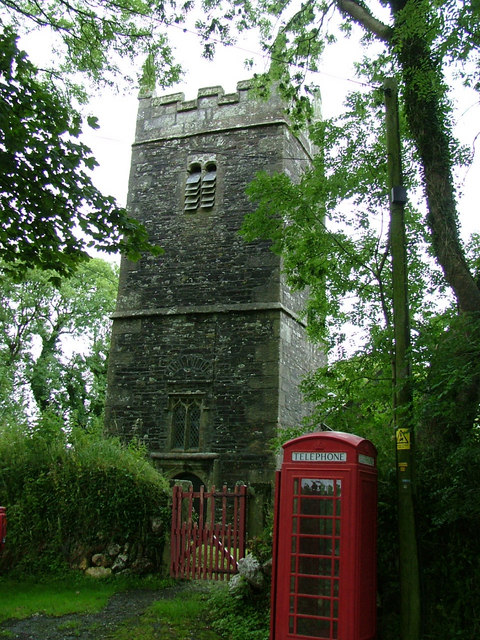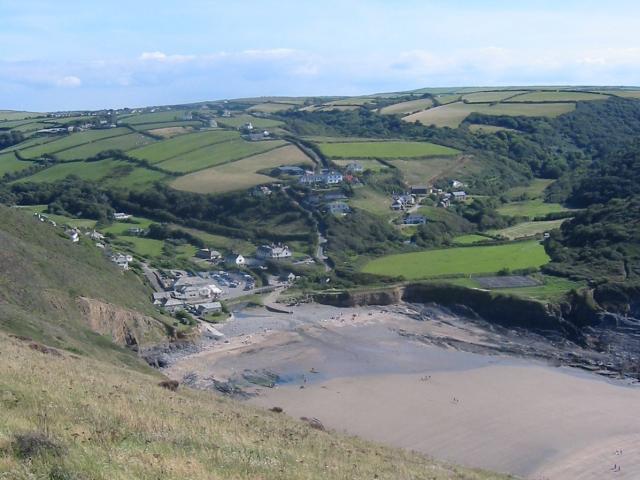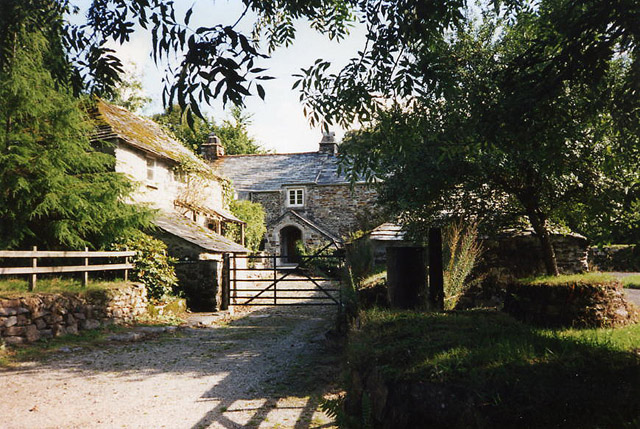|
Otterham
Otterham ( kw, Prasotri) is a village and a civil parish in north Cornwall, England, United Kingdom. The village is situated approximately south of Bude and north of Camelford.Ordnance Survey: Landranger map sheet 190 ''Bude & Clovelly'' Otterham Mill, Otterham Down and Otterham Station (''see below'') are neighbouring settlements to Otterham village; all take the name from the River Ottery which rises in the parish. The parish is in the Hundred of Lesnewth and Deanery of Trigg Major. It is in the Registration District of Camelford and belongs to the Boscastle group of Anglican parishes. Otterham parish is bounded to the north by St Gennys, to the east by Warbstow, to the south by Davidstow and to the west by St Juliot. The parish is rural with small hamlets and farmsteads spread fairly evenly across it: the population of the parish in the 2001 census was 228. The parish church of St Denis at is in Otterham village and has a 40 ft tower housing three bells. The ch ... [...More Info...] [...Related Items...] OR: [Wikipedia] [Google] [Baidu] |
St Denis' Church, Otterham
St Denis's Church, Otterham is a Grade II* listed parish church in the Church of England Diocese of Truro in Otterham, Cornwall. History The dedication to St. Denis is undocumented according to Charles G. Henderson who observes that nearby land was called St Tenye in 1613. (Other dedications to this saint in Cornwall are found at Trevena and North Tamerton.) The church dates from the Norman period. The tower may have been rebuilt in 1702. The church was restored between 1889 and 1904; at which time the north transept was demolished and much old woodwork was removed.''Cornish Church Guide'', p. 173 Parish status The church is in the Boscastle and Tintagel group of parishes which includes *St Symphorian's Church, Forrabury *St Merteriana's Church, Minster *St Materiana's Church, Tintagel *St Michael and All Angel's Church, Lesnewth *St Julitta's Church, St Juliot *The Holy Family Church, Treknow * St Piran's Church, Trethevy *St Petroc's Church, Trevalga Bells & organ The o ... [...More Info...] [...Related Items...] OR: [Wikipedia] [Google] [Baidu] |
North Cornwall Railway
The North Cornwall Railway was a railway line running from Halwill in Devon to Padstow in Cornwall via Launceston, Camelford and Wadebridge, a distance of . Opened in the last decade of the nineteenth century, it was part of a drive by the London and South Western Railway (LSWR) to develop holiday traffic to Cornwall. The LSWR had opened a line connecting Exeter with Holsworthy in 1879, and by encouraging the North Cornwall Railway it planned to create railway access to previously inaccessible parts of the northern coastal area. "There are few more fascinating lines than the one which leads to North Cornwall from Okehampton" says T.W.E. Roche in his popular tribute to the network of railway lines operated by the London and South Western Railway (LSWR) in North and West Devon and North Cornwall. History First railways In the nineteenth century, Padstow was an important fishing port, but it was hampered by lack of land communication with its markets. The Bodmin and Wadebridge ... [...More Info...] [...Related Items...] OR: [Wikipedia] [Google] [Baidu] |
River Ottery
The River Ottery ( kw, Otri) is a small river in northeast Cornwall, United Kingdom. The river is about long from its source southeast of Otterham to its confluence with the River Tamar at Nether Bridge, northeast of Launceston. The headwaters of the River Ottery are within the civil parish of Otterham but formerly came under the parish of Forrabury and Minster. In 1311, the rector of that parish wrote: "..the river Ottery takes its rise in this parish and flows to Canworthy Water and so by Yeolmbridge to the river Tamar." Hydrology and course With its tributaries, the River Ottery forms a major sub-catchment of the Tamar system, draining of north Cornwall. The River Ottery's catchment area is within the Carboniferous geological formation known as the Culm Measures which stretches from Dartmoor to north Devon and across northeast Cornwall as far west as Bodmin Moor. The infant river initially flows north until it reaches the hamlet of Trengune. From here it adopts an ... [...More Info...] [...Related Items...] OR: [Wikipedia] [Google] [Baidu] |
Civil Parishes In Cornwall
A civil parish is a country subdivision, forming the lowest unit of local government in England. There are 218 civil parishes in the ceremonial county of Cornwall, which includes the Isles of Scilly. The county is effectively parished in its entirety; only the unpopulated Wolf Rock is unparished. At the 2001 census, there were 501,267 people living in the current parishes, accounting for the whole of the county's population. The final unparished areas of mainland Cornwall, around St Austell, were parished on 1 April 2009 to coincide with the structural changes to local government in England. Population sizes within the county vary considerably, Falmouth is the most populous with a population of 26,767, recorded in 2011, and St Michael's Mount the least with 29 residents. The county is governed by two separate unitary authorities; Cornwall Council covers mainland Cornwall, while the Isles of Scilly are administered by their own unitary authority. History Parishes arose fr ... [...More Info...] [...Related Items...] OR: [Wikipedia] [Google] [Baidu] |
Lesnewth (hundred)
Lesnewth Hundred is one of the former hundreds of Cornwall, Trigg was to the south-west and Stratton Hundred to the north-east. Tintagel, Camelford, Boscastle, and Altarnun were in the Hundred of Lesnewth as well as Lesnewth which is now a hamlet but in pre-Norman times was the seat of a Celtic chieftain who was said to rule the whole of Trigg. Maclean, John (1872–79) ''The Parochial History of the Deanery of Trigg Minor''. London: Nichols & Co. The division into hundreds is thought to date from the reign of King Athelstan and at the time of the Domesday Survey the internal order of manors in the Exeter Domesday Book for Cornwall is in most cases based on the hundreds to which they belonged (though the hundred names are not used). In the Geld Inquest of 1083 only seven hundreds are found, identified by the names of the chief manors: Connerton, Winnianton, Pawton, Tybesta, Stratton, Fawton and Rillaton. Here Stratton represents a single hundred including the later Stratto ... [...More Info...] [...Related Items...] OR: [Wikipedia] [Google] [Baidu] |
Boscastle
Boscastle ( kw, Kastel Boterel) is a village and fishing port on the north coast of Cornwall, England, in the civil parish of Forrabury and Minster (where the 2011 Census population was included) . It is south of Bude and northeast of Tintagel. The harbour is a natural inlet protected by two stone harbour walls built in 1584 by Sir Richard Grenville and is the only significant harbour for along the coast. The village extends up the valleys of the River Valency and River Jordan. Heavy rainfall on 16 August 2004 caused extensive damage to the village. Boscastle lies within the Cornwall Area of Outstanding Natural Beauty (AONB). The South West Coast Path passes through the village. History Boscastle was first inhabited by the Bottreaux family around 1080, and the name of the village comes from Bottreaux Castle (pronounced "Botro"), a 12th-century motte-and-bailey fortress, of which few remains survive. The castle, built sometime between 1154 and 1189 by Sir William des Bottr ... [...More Info...] [...Related Items...] OR: [Wikipedia] [Google] [Baidu] |
St Gennys
St Gennys ( kw, S. Gwynnas) is a coastal civil parish and small settlement in north Cornwall, England, United Kingdom. The hamlet of St Gennys is about seven miles (11.3 km) southwest of Bude.Ordnance Survey: Landranger map sheet 190 ''Bude & Clovelly'' It is on high ground half-a-mile north of the coastal village of Crackington Haven, the major settlement in the parish. The only other settlements of any size in the parish are Middle Crackington and Higher Crackington both of which are southeast of Crackington Haven, half-a-mile and one mile distant respectively. The population of the parish at the 2011 census was 873. History and geography The name St Gennys is generally thought to derive from 4th Century Christian martyr Saint Genesius although it has been suggested that the commemoration is to the Welsh Saint Gwynws. In either case the name is old and several places in the parish are mentioned in the Domesday Book including Crackington (as ''Crachemua''), Dizzard ( ... [...More Info...] [...Related Items...] OR: [Wikipedia] [Google] [Baidu] |
Villages In Cornwall
A village is a clustered human settlement or community, larger than a hamlet but smaller than a town (although the word is often used to describe both hamlets and smaller towns), with a population typically ranging from a few hundred to a few thousand. Though villages are often located in rural areas, the term urban village is also applied to certain urban neighborhoods. Villages are normally permanent, with fixed dwellings; however, transient villages can occur. Further, the dwellings of a village are fairly close to one another, not scattered broadly over the landscape, as a dispersed settlement. In the past, villages were a usual form of community for societies that practice subsistence agriculture, and also for some non-agricultural societies. In Great Britain, a hamlet earned the right to be called a village when it built a church. [...More Info...] [...Related Items...] OR: [Wikipedia] [Google] [Baidu] |
John MacLean (historian)
Sir John Maclean KB, FSA (17 September 1811 – 5 March 1895) was a British civil servant, genealogist and author. Life Maclean was born John Lean, a son of Robert Lean, of Trehudreth in the parish of Blisland in Cornwall, where he was born in 1811. His mother was Elizabeth Every, a daughter of Thomas Every, of Bodmin, Cornwall. After genealogical research his ancestors were connected to the Scottish Clan Maclean, and in 1845, with his brothers, he added to his surname the prefix "Mac". In 1837 he entered the Ordnance Department of the War Office, and became deputy auditor in April, 1865. He resigned this post on a pension, and received a knighthood in January, 1871. Sir John Maclean died at his residence, Glasbury House, Richmond Hill, Clifton, Bristol, of influenza. on Tuesday 5 March 1895. Family In 1835 at Helland in Cornwall, he married Mary Billing, eldest sister and co-heiress of Thomas Billing, of Lanke, Cornwall. Writings Sir John's ''Parochial History of the Deane ... [...More Info...] [...Related Items...] OR: [Wikipedia] [Google] [Baidu] |
River Camel
The River Camel ( kw, Dowr Kammel, meaning ''crooked river'') is a river in Cornwall, England. It rises on the edge of Bodmin Moor and with its tributaries its catchment area covers much of North Cornwall. The river flows into the eastern Celtic Sea between Stepper Point and Pentire Point having covered about 30 miles, making it the second longest river wholly in Cornwall. The river is tidal upstream to Egloshayle and is popular for sailing, birdwatching and fishing. The name ''Camel'' comes from the Cornish language for 'the crooked one', a reference to its winding course. Historically the river was divided into three named stretches. Heyl ( kw, Heyl, meaning ''estuary'') was the name for the estuary up to Egloshayle, the River Allen ( kw, Dowr Alen, meaning ''shining river'') was the stretch between Egloshayle and Trecarne, whilst the Camel was reserved for the stretch of river between its source and Trecarne. Geology and hydrology The River Camel rises on Hendraburnick D ... [...More Info...] [...Related Items...] OR: [Wikipedia] [Google] [Baidu] |
Tumulus
A tumulus (plural tumuli) is a mound of earth and stones raised over a grave or graves. Tumuli are also known as barrows, burial mounds or '' kurgans'', and may be found throughout much of the world. A cairn, which is a mound of stones built for various purposes, may also originally have been a tumulus. Tumuli are often categorised according to their external apparent shape. In this respect, a long barrow is a long tumulus, usually constructed on top of several burials, such as passage graves. A round barrow is a round tumulus, also commonly constructed on top of burials. The internal structure and architecture of both long and round barrows has a broad range; the categorization only refers to the external apparent shape. The method of may involve a dolmen, a cist, a mortuary enclosure, a mortuary house, or a chamber tomb. Examples of barrows include Duggleby Howe and Maeshowe. Etymology The word ''tumulus'' is Latin for 'mound' or 'small hill', which is deri ... [...More Info...] [...Related Items...] OR: [Wikipedia] [Google] [Baidu] |









